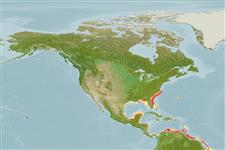Common names from other countries
Classification / Names / Names
Common names | Synonyms | Catalog of Fishes (gen., sp.) | ITIS | CoL | WoRMS
Environment: milieu / climate zone / depth range / distribution range
Ecology
Benthopelagic. Tropical; 30°N - 20°S, 90°W - 38°W
Western Central Atlantic: Tobago.
Length at first maturity / Size / Weight / Age
Maturity: Lm ? range ? - ? cm Max length : 0.3 cm BL male/unsexed; (Ref. 3682)
Benthic, neritic (Ref. 3682). Mean latitude of occurrence = 12.5 (NS); No known presence in China (Ref. 125708).
Life cycle and mating behavior
Maturity | Reproduction | Spawning | Eggs | Fecundity | Larvae
Members of the phylum Chaetognatha are hermaphroditic. Mating behavior: A preliminary visual signaling behavior for species recognition is observed to prevent predation. Life cycle: Eggs directly develop into miniature adults (hatchlings).
McLelland, J.A., R.W. Heard and J.D. Hardy Jr. 1992. (Ref. 3667)
IUCN Red List Status (Ref. 130435)
CITES status (Ref. 108899)
Not Evaluated
Not Evaluated
Human uses
| FishSource |
Tools
More information
Age/Size
Growth
Length-weight
Length-length
Morphology
Larvae
Abundance
Internet sources
Estimates based on models
Vulnerability
Low vulnerability (10 of 100).
Price category
Unknown.
